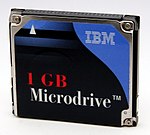Data sizes and speeds
| Educational level: this is a secondary education resource. |
| Completion status: this resource is ~75% complete. |
| Type classification: this is a lesson resource. |
| Completion status: this resource is considered to be ready for use. |
Course Navigation
| << Previous - Basic operations | Next - Motherboard >> |
|---|
Supplemental Course Navigation
Pre. - Supplemental Page << Numeral systems
Next - Supplemental Page >> Data Coding and Information Decoding
This is a lesson in the course Introduction to Computers, which is a part of The School of Computer Science This is a lesson in the course Computing Fundamentals
Names for different sizes of data
[edit | edit source]When choosing a new computer we come across terms such as "300GB hard drive" and "500MB download", and to the uninitiated, this can be somewhat disconcerting. These numbers represent amounts of data. Data in a computer is represented in a series of bits. A bit is the smallest form of data that a computer can store and process. Every bit exists as one of two values, 0 or 1. Since the birth of computers, bits have been the language that control the processes that take place inside that mysterious box called your computer. In this article, we look at the very language that your computer uses to do its work.
Bit
[edit | edit source]A bit is a binary unit, simply a 1 or a 0. A true or a false. It is the most basic unit of data in a computer. It's like the dots and dashes in Morse code for a computer. Bits are machine readable.
Nibble
[edit | edit source]A nibble is 4 bits. One hexadecimal digit is one nibble in size.
Byte
[edit | edit source]In computer science a byte is a unit of measurement of information storage, that equals '8 bits', can be used to represent letters and numbers.

For example, the number 01000001 is 8 bits long, and represents the letter A in 8-bit encoding.
Word
[edit | edit source]Unfortunately the term "word" has two definitions.(1) The word size for a computer is the number of bits that the central processing unit (CPU) of a particular computer can handle at one time. These word sizes range from a nibble to more than 128 bits. (2) Word size = 16 bits (or two bytes). This second definition was pretty much driven by all of the people that were writing software to be used to program computers.
KB
[edit | edit source]A kilobyte, or KB, is a unit of data that equals 1024 bytes, or 210. This is not to be confused with the decimal kilo which means 1000 or 103. The difference is because the term was coined by computer scientists. Powers of 2 do not fit into 1000 neatly, therefore using the decimal system in binary computing would be computationally wasteful.
MB
[edit | edit source]A megabyte, or MB, is a unit of data that equals 1,048,576 bytes, or 220. This is equal to a kilobyte squared, 10242.
GB
[edit | edit source]
A gigabyte, or GB, is a unit of data that equals 1,073,741,824 bytes, or 230. This is equal to a kilobyte cubed, 10243. Because of the difference between computer metrics and decimal metrics, storage devices are usually advertised with gigabytes presented as 1 billion bytes rather than 1.07 billion bytes, thereby understating their true capacity. This explains why there are inconsistencies when comparing the actual size of a hard drive to the presented size.
TB
[edit | edit source]A terabyte, or TB, is a unit of data that equals 1,099,511,627,776 bytes, or 240. This is equal to a kilobyte to the fourth power, 10244, being approximately one trillion bytes, or 1024 gigabytes. Consumer storage devices are often measured in terabytes.
PB
[edit | edit source]
A petabyte, or PB, is a unit of data that equals 1,125,899,906,842,624 bytes, or 250. This is equal to a kilobyte to the fifth power, 10245, or roughly one quadrillion bytes. Large data centers, such as those operated by Google, can handle petabytes of data every day. Microsoft stores on 900 servers a total of approximately 14 petabytes. Cisco Systems predicts "the global Internet networks will deliver 12.5 petabytes every 5 minutes in 2016."
Measurements of Data Speed
[edit | edit source]
Data transfer speeds can be measured in bits per second, or in bytes per second. A byte is (generally) 8 bits long. Network engineers describe network speeds in bits per second, while web browsers usually measure a file download rate in bytes per second. A lowercase "b" usually means a bit, while an uppercase "B" represents a byte. In networking, metric prefixes (e.g. kilo, mega, and giga) refer to their decimal, not binary meaning.
bps
[edit | edit source]Known as bits per second, bps was the main way of describing data transfer speeds several decades ago.
Kbps
[edit | edit source]Kilobits per second, or 1000 bits per second. The quality of compressed audio files (e.g. MP3s) are typically measured in Kbps.
Mbps
[edit | edit source]Megabits per second, or 1,000,000 bits per second. Internet service providers usually measure their Internet connectivity in Mbps.
Gbps
[edit | edit source]Gigabits per second, or 1,000,000,000 bits per second. Modern local area networks, Internet infrastructure, and consumer Internet connections in some countries can operate at these speeds.
Supplemental Course Navigation
[edit | edit source]Pre. - Supplemental Page << Numeral systems
Next - Supplemental Page >> Data Coding and Information Decoding Course Navigation
| << Previous - Basic operations | Next - Motherboard >> |
|---|
